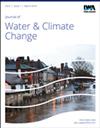Development of daily bias-corrected ensemble precipitation estimates over the Upper Indus Basin of the Hindukush-Karakoram-Himalaya
IF 3.1
4区 环境科学与生态学
Q2 WATER RESOURCES
引用次数: 0
Abstract
Abstract Accurate precipitation estimates over space and time are critically important, particularly in data-scarce areas, for effective hydrological modeling and efficient regional water resources management. Gridded precipitation datasets are the preeminent alternative in such areas. However, gridded precipitation datasets contain different kinds of uncertainties owing to the retrieval algorithms used in their development. In this study, five precipitation datasets (Tropical Rainfall Measuring Mission (TRMM), Climate Prediction Centre (CPC), APHRODITE, Climate Hazards Group Infra-Red Precipitation with Station data (CHIRPS), and PERSIANN) were evaluated, and an ensemble of daily precipitation datasets from 2001 to 2017 at a resolution of 0.05 degree was created based on three ensemble approaches (Bayesian model ensemble, relative bias-based ensemble, and correlation-based ensemble) over the Upper Indus basin. To improve the accuracy of the ensemble dataset, a linear bias correction technique is applied with respect to gauging precipitation. The accuracy of the bias-corrected ensemble dataset was evaluated using statistical and novelty categorical measures. A reasonable agreement was found between the ensemble and gauge precipitation (Pearson correlation 0.83–0.89 and relative bias 1–8.7 mm/month), while large biases were noted in five precipitation datasets (1.7–53.9 mm/month). The study suggests that utilizing ensemble approaches to gridded precipitation can significantly enhance the accuracy of the estimates compared to relying on a single precipitation dataset.兴都库什-喀喇昆仑-喜马拉雅上印度河流域日偏校正整体降水估算的发展
准确的空间和时间降水估算对于有效的水文建模和高效的区域水资源管理至关重要,特别是在数据稀缺的地区。网格降水数据集是这些地区的卓越选择。然而,网格降水数据集由于其开发过程中使用的检索算法而包含不同类型的不确定性。利用热带降雨测量任务(TRMM)、气候预测中心(CPC)、APHRODITE、气候灾害组红外降水与站数据(CHIRPS)和PERSIANN 5个降水数据集,基于贝叶斯模型集合、基于相对偏倚的集合和基于相关性的集合,构建了2001 - 2017年印度河上游流域逐日降水数据集,分辨率为0.05度。为了提高集合数据集的精度,采用线性偏差校正技术对降水进行测量。使用统计和新颖性分类措施评估偏差校正集合数据集的准确性。集合与实测降水具有较好的一致性(Pearson相关0.83 ~ 0.89,相对偏差1 ~ 8.7 mm/月),而5个降水数据集(1.7 ~ 53.9 mm/月)存在较大偏差。研究表明,与依赖单一降水数据集相比,利用网格化降水的集合方法可以显著提高估算的准确性。
本文章由计算机程序翻译,如有差异,请以英文原文为准。
求助全文
约1分钟内获得全文
求助全文
来源期刊

Journal of Water and Climate Change
WATER RESOURCES-
CiteScore
4.80
自引率
10.70%
发文量
168
审稿时长
>12 weeks
期刊介绍:
Journal of Water and Climate Change publishes refereed research and practitioner papers on all aspects of water science, technology, management and innovation in response to climate change, with emphasis on reduction of energy usage.
 求助内容:
求助内容: 应助结果提醒方式:
应助结果提醒方式:


